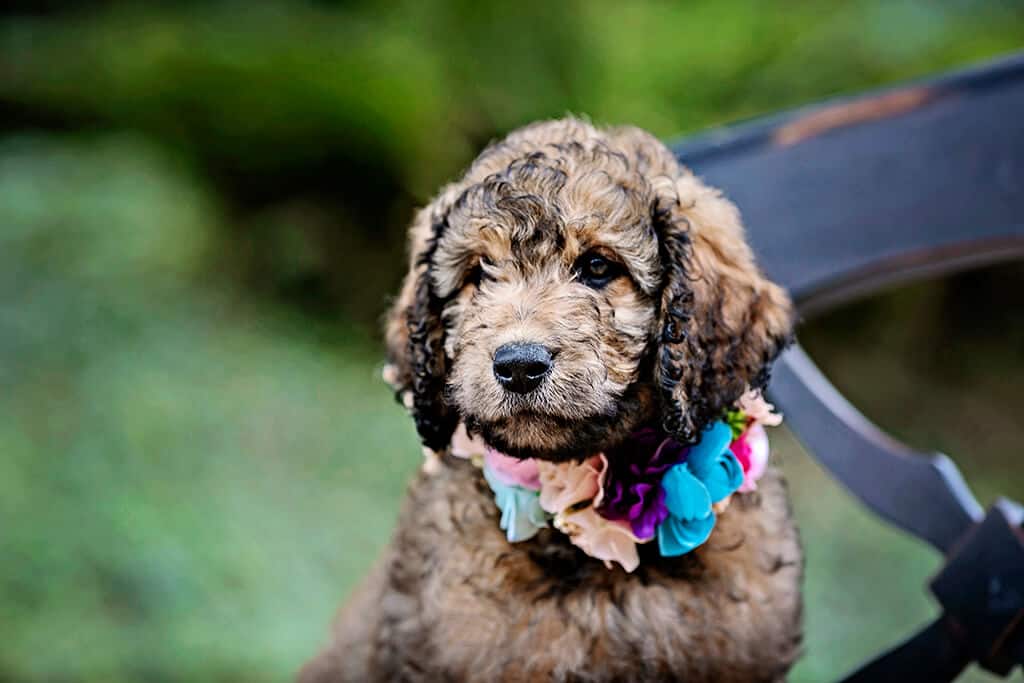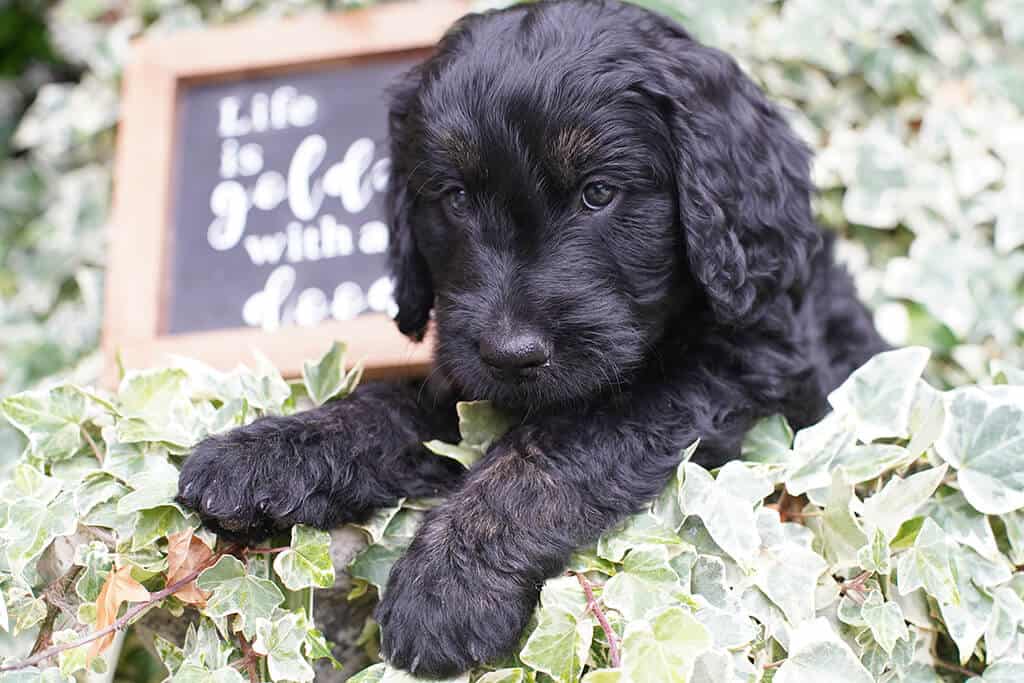The dog’s size is among the most important decisions recommended for getting a Goldendoodle to one’s house. The Mini Goldendoodle vs. Goldendoodle issue cuts across different families since the two breeds come with visible merits and demerits.
Though these two types of dogs are mixed breeds of the Poodle and the golden retriever equally, understanding the variations in the standard and mini goldendoodle will, therefore, assist in picking the right pet to meet the family’s needs.
In this article, we will discuss the differences you need to know regarding Mini Goldendoodles and Goldendoodles, in terms of size, exercise, behavior, maintenance, and more individual characteristics. We will also respond to questions asked most often and assist you in choosing the Goldendoodle size that is most appropriate for your house.
Mini Goldendoodle or Goldendoodle – Key Differences
The Mini Goldendoodle and Goldendoodle are two adorable dog breeds that boast intelligence, friendliness, and hypoallergenic properties. Nevertheless, their main differences come down to size, activity levels, and maintenance. Let’s explore these aspects in more detail.
1. Size and Weight
The main distinguishing feature of a miniature goldendoodle versus a goldendoodle is its physical size. Miniature Goldendoodles are smaller versions of Goldendoodles, and their petite stature is usually determined by the standard Poodle parent who can weigh around 130 to 150 pounds. A Mini Goldendoodle is typically 13 to 20 inches tall at the shoulder and weighs anywhere from 15 to 35 pounds.
A fully grown standard Goldendoodle however is way bigger ranges from 20 to 24 inches in height and weighs anywhere between 40 and 90 pounds in weight. However, while the larger Goldendoodle may seem scary at first, its playful side provides it with a suitable temperament for a family dog.
Those who live alone or with their families in small houses or apartments will find that more often than not, a Mini Goldendoodle is selected since it is small. This is because they do not take much space thus, they are loose and easy to control in confined areas. On the other hand, the Standard Goldendoodles have to be contained in larger areas and have quite a large yard for them to expend the high energy levels that they have.
2. Demands for Physical Activity and Exercise Levels

In terms of physical exercise for the Mini Goldendoodle and the Goldendoodle themselves, both pets need regular physical activity daily although the level of exercise relates to their size and energy levels. The Mini Goldendoodle is not considered a strenuous pet but still requires a fair level of exercise to keep depression at bay. Every day, walks, playtime, and stimulation will be required for a Mini Goldendoodle to remain active.
Contrarily, the standard Goldendoodles are more energetic than the other types due to their size and athleticism according to their parent the Golden Retriever. Typically, standard Goldendoodles must get at least an hour’s worth of physical exercise a day consisting of such exercises as brisk walking, running, and hiking or even exercising by playing fetch. If you lead a very active lifestyle and can offer your dog running and exploring opportunities, then the standard Goldendoodle is ideal for you.
3. Temperament and personality
The Goldendoodle breed, at all of its sizes, is characterized by amicability, affection, and intelligence. Many children, other pets, and strangers are all able to foster these breeds, for example, Mini Goldendoodle vs Goldendoodle. These dogs are quite trainable and attentive which is an added advantage for people from different families.
Nevertheless, there is a certain level of behavior differences which could also play a role in making the choice. As it appears, Mini Goldendoodles seem to adjust a little more to changes in activity than their counterparts do. Their smaller size and slightly lowered activity levels allow them to be ideal for families that have smaller children or older people who tend to be less active.
On the flip side, a standard Goldendoodle’s loving temperament and more active way of living would better suit existing families or people who engage in outdoor activities. A standard Goldendoodle is likely to be a more suited option for you if an active dog that keeps pace with your schedule is what you need.
4. Grooming and Coat Maintenance

Both the Mini Goldendoodle vs. Goldendoodle have coats that also carry the wavy or curly texture of the Poodle parent, which means that their grooming will need to be taken care of for them to look and stay healthy. One of the greatest assets of the Goldendoodles puppies is that they have a low shedding coat, which makes them ideal for people who are allergic.
The Mini Goldendoodle although smaller in stature has a lesser amount of coat to maintain but frequent brushing is still necessary to prevent burrs and matting. You should allow for professional grooming for your Mini Goldendoodle at least once in 6 to 8 weeks so that its long-haired coat remains curly.
The grooms of the standard Goldendoodle differs as it is thicker hence the grooming is more rigorous. To keep the standard Goldendoodle’s coat glossy and free of tangles, the dog needs brushing at least two to three times a week. Like the Mini Goldendoodle, the standard Goldendoodle will need regular grooming appointments every 6 to 8 weeks. If such appointments are not kept, matting will occur which may lead to problems with the skin and other infections.
5. Health Issues
The Mini Goldendoodle and Goldendoodle are typically healthy breeds, but like any other breed, they tend to have health issues that they are at risk of inheriting from their progenitor breeds. The health issues may include hip dysplasia, elbow dysplasia, and cardiomyopathy which are common on the Golden Retriever side of the family. On the other hand, issues that may arise from the Poodle side include progressive retinal atrophy (PRA) which causes blindness as well, and Addison disease, which affects the adrenal glands.
In general, Mini Goldendoodles may suffer fewer health-related issues as compared to standard sizes because of the size factor. Despite this, it is advisable to look for an established pet breeder who screens their breeding stock for common hereditary conditions. Frequent visits to the veterinarian, proper nutrition, and physical activity can contribute to prolonging the lifespan of Goldendoodles.
Standard vs Mini Goldendoodle: Which is the Best Option?

So, how do you go about it when it comes to choosing Mini Goldendoodle vs. Goldendoodle? In the end, the choices concerning the decision will lean toward the family’s housing conditions, activity levels, and preferences.
For instance, if your living space is relatively small such as in the case of living in an apartment or a condo or you want a dog that does not need a lot of vigorous activity, a Mini Goldendoodle is a viable option. They do well in more confined spaces and generally require somewhat less exercise than their other counterparts.
In case you have a huge house or ample open area, take part in outdoor activities, or have an extremely active family then standard Goldendoodles are likely to suit you better. Due to their large frame and energetic levels, they own cottage homes where there is more space and active involvement.
Mini Goldendoodle

Pros
- Perfect for limited accommodation: Their small structure is beneficial for people who live in an apartment or a one-bedroom condo
- Less level of energy: Mini Goldendoodles are still active; however, they are less active than the larger breeds and require less exercise
- Easier pets for young kids: Mini Goldendoodles are considered easier for younger children as they are smaller in size compared to the standard Goldendoodles
Cons
- Can still suffer from health defects: In comparison to health status in general, Mini Goldendoodles are still to be bred without the defects within both parent types of breeds.
- More grooming needed than anticipated: Being small dogs, every goldendoodle miniature still needs to be groomed every so often to prevent the hair from knotting and tangling
Regular (Standard) Goldendoodle
Pros
- Ideal for energetic siblings: Families who love to partake in diverse outdoor sporting activities, will find the Standard Goldendoodles to be ideal.
- Social and loved by anyone: They are warm loving dogs that are ideal for families and are also friendly with other pets in the household.
- Ranch, estates, or houses with many children and pets are not a problem to them: Standard Goldendoodles are quite versatile and can be comfortable in different settings.
Cons
- Increased levels of aggressiveness: They since require much open space and more rigorous physical activities.
- Grooming consistency is more intensive: This is because the dogs are bigger. Grooming sessions also take a longer period.
Can You Breed A Mini Goldendoodle With A Standard Goldendoodle?
Indeed, it can be done to get a Mini Goldendoodle bred with a Standard Goldendoodle. This is attempted by some breeders for size-ranging puppies to be produced, the outputs are however in most cases different or varying. The offspring are likely to be between the size of a Mini Goldendoodle and Standard Goldendoodle depending on how much contribution each parent can make genetically.
In the same sense, crossbreeding these two sizes to achieve the desired results can be very complicated. The size of the pups may vary with some of the pups attaining the size of the mini parent, while other pups may reach the size of the standard parent. Responsible breeders will consider the genetics of each dog in a breeding pair to make certain that a desired size is achieved, but genetic variation will occur and is normal.
FAQs
1. Is a Mini Goldendoodle Better than a Goldendoodle?
This is based on individual lifestyles and preferences. Mini Goldendoodles are perfect for families living in cramped spaces such as apartments or those wishing for a less active dog. Active families or members who are always on the go and have ample space will find standard Goldendoodles an appropriate breed as they are large and more energetic.
2. Can a Mini Goldendoodle be Crossed with a Standard Goldendoodle?
Yes, it is possible to mix breed Mini Goldendoodles with standard ones. However, the sizes of puppies obtained will be diverse. Practical breeding procedures can contribute to the possibility of achieving the desired results.
3. How Long Do Goldendoodles Live?
The average lifespan of the Goldendoodles is expected to be in the range of 10-15 years but life expectancy for more individual cases may depend upon certain determinants such as genetics, diet, exercise, health care, etc.
4. Are There Any Mini Goldendoodles?
The answer is Yes, the Mini Goldendoodle is a smaller version of the standard Goldendoodle, weighs approximately 15 to 35 pounds in weight, and is 13 to 20 inches tall.
5. How much exercise should I give a Mini Goldendoodle?
On average, Mini Goldendoodles require around 30 to 60 minutes of exercise every day, which includes walks, playing, and providing a mental challenge. Exercise consistently is important if they are to remain healthy, and well-behaved.
Conclusion
The differences between a Mini Goldendoodle vs. Goldendoodle are the type of lifestyle being lived, the available living space, and how much time can be devoted to walking and grooming. Both sizes make lovely family pets but the Mini Goldendoodle is ideal for compact living conditions or families who tend to be more easygoing. The standard Goldendoodle, owing to its bigger frame and greater levels of energy, is suited to families with more room and an active lifestyle.
Whichever size you opt for, Mini and Standard Goldendoodles come with the same package of appealing qualities: smart, loving, and low shedding. Which one is the right choice for your family will depend on your environment, levels of activity, and how much attention you are willing to offer.




